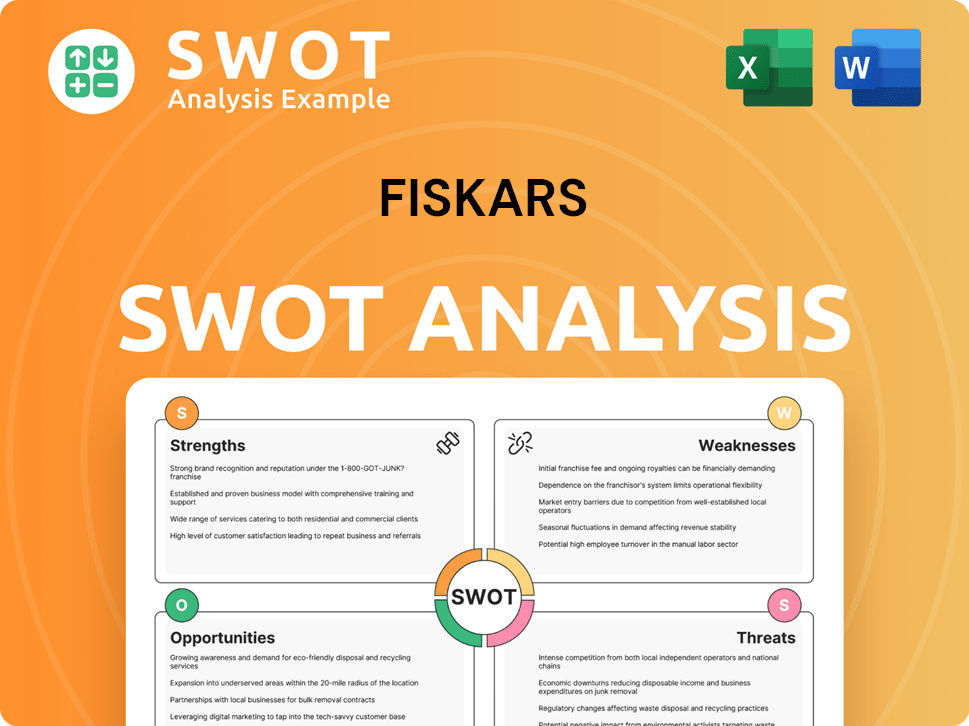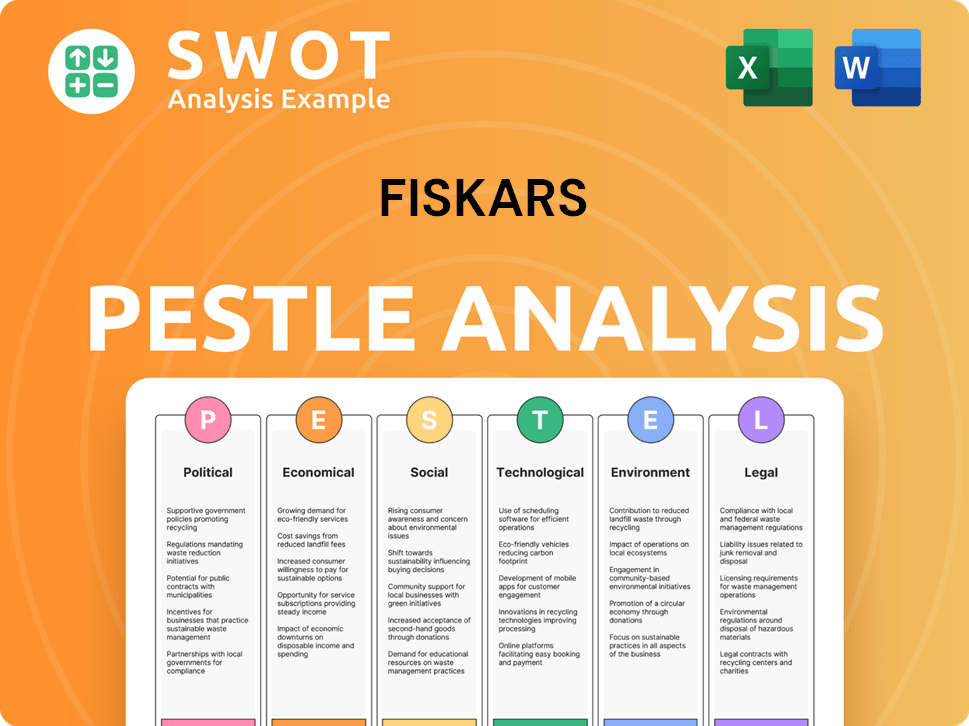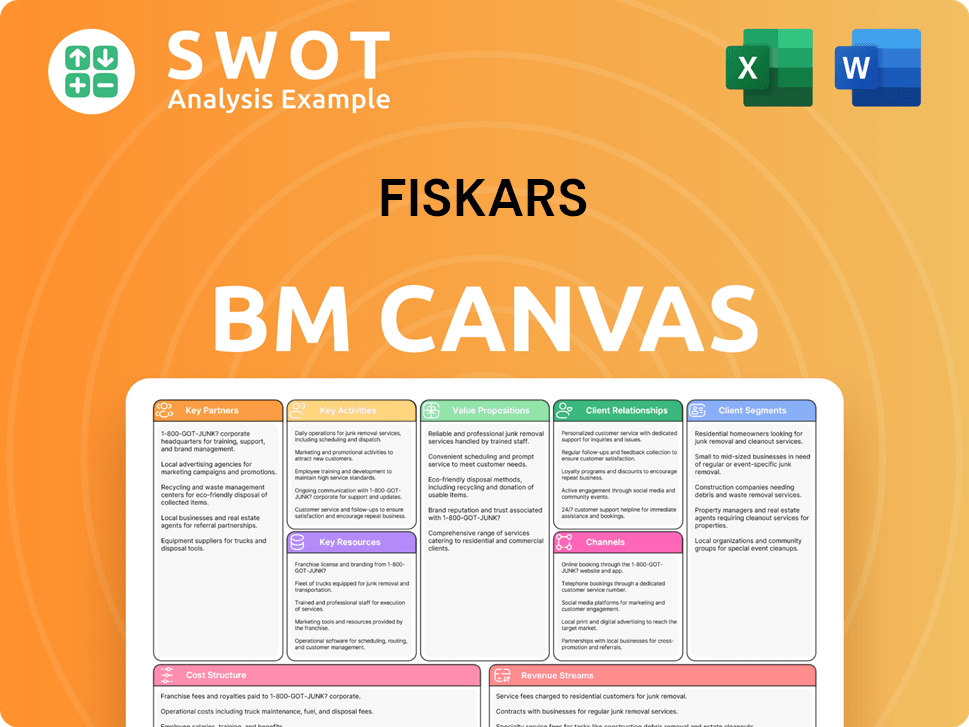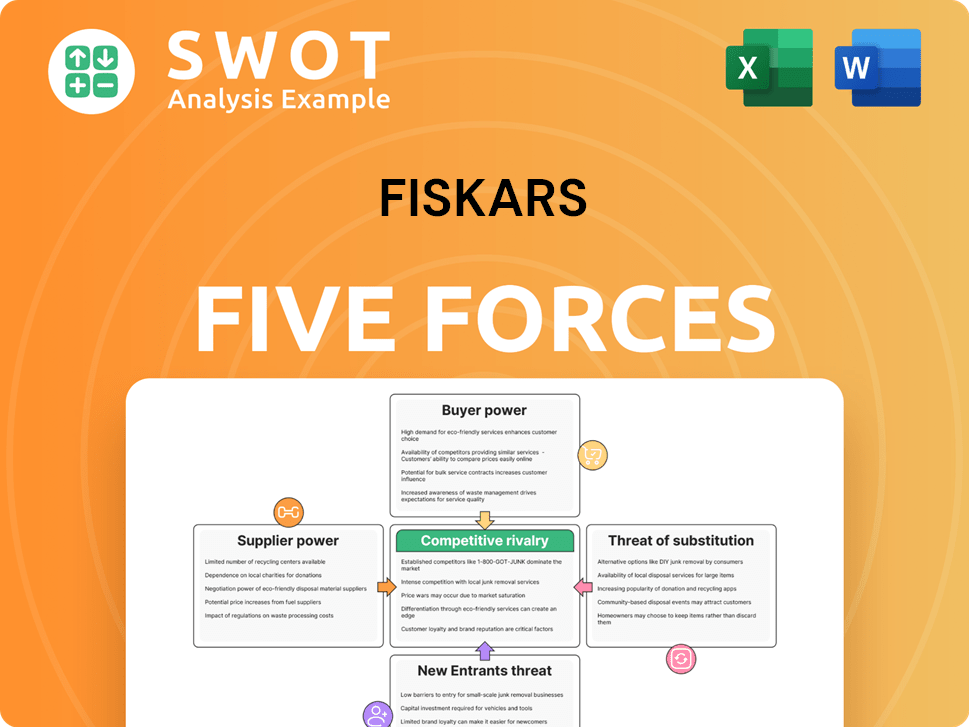Fiskars Bundle
How Does Fiskars Navigate the Ever-Changing Competitive Landscape?
From its humble beginnings in 1649, Fiskars has transformed from an ironworks to a global consumer goods leader. This evolution, marked by iconic products like the orange-handled scissors, showcases Fiskars' remarkable ability to adapt and thrive. But how does this legacy translate into today's fiercely competitive market?

This deep dive into the Fiskars SWOT Analysis will uncover the intricacies of the Fiskars competitive landscape, providing a comprehensive Fiskars market analysis. We'll explore Fiskars competitors, dissecting their strengths and weaknesses, alongside a detailed Fiskars industry analysis. Understanding Fiskars' company overview, its competitive advantages and disadvantages, and its strategic positioning within the global market is crucial for investors and strategists alike.
Where Does Fiskars’ Stand in the Current Market?
The Fiskars competitive landscape is significantly shaped by its diverse product portfolio and global presence within the home, garden, and outdoor consumer products industry. The company's core operations encompass the design, manufacturing, and distribution of a wide range of products, including gardening tools, crafting and cooking essentials, and luxury tableware. This broad scope allows it to cater to various customer segments, from professional gardeners to home decorators, underpinning its robust market position.
Fiskars' value proposition centers on offering high-quality, design-led products that enhance everyday living. This approach is evident in its strategic shift towards premiumization, particularly in segments like Living and Watering. The company's commitment to innovation, coupled with its strong brand heritage, enables it to differentiate itself in a competitive market. Furthermore, its emphasis on digital transformation and e-commerce strengthens its ability to meet evolving consumer preferences.
In 2023, the company reported comparable net sales of EUR 1,257.6 million, with a comparable EBIT of EUR 151.0 million, demonstrating its financial scale. The company's geographic presence is particularly strong in Europe and North America, with expanding reach into Asia. The company's financial health remains robust, as evidenced by its solid profitability and cash flow generation. This solid financial performance is a key factor in its competitive positioning.
Fiskars holds a significant market position, though specific market share figures fluctuate. The company's consistent performance and strategic acquisitions have solidified its standing in the home, garden, and outdoor consumer products industry. Its diverse brand portfolio and global reach are key contributors to its market share.
The company's product lines span gardening tools, crafting and cooking essentials, and luxury tableware and decorative items. These products cater to a wide array of customer segments, from professional gardeners to home decorators. This diversified portfolio helps Fiskars maintain a strong position in the market.
Fiskars has a strong presence in Europe and North America, with expanding reach into Asia. This global footprint supports its overall market position and provides opportunities for growth. The company's ability to adapt to local market conditions is crucial.
Fiskars Group's financial health is robust, as evidenced by its solid profitability and cash flow generation. The company's financial stability allows it to invest in innovation and expansion. This solid financial performance supports its competitive advantage.
Fiskars differentiates itself through premiumization, design-led offerings, and digital transformation. The company focuses on enhancing its e-commerce capabilities to meet evolving consumer purchasing habits. Strategic acquisitions have also played a key role in shaping its competitive landscape.
- Premiumization: Focusing on high-quality, design-led products.
- Digital Transformation: Enhancing e-commerce capabilities.
- Strategic Acquisitions: Expanding its product portfolio and market reach.
- Global Presence: Strong in Europe and North America, expanding into Asia.
For a deeper dive into the origins and evolution of the company, you can explore the Brief History of Fiskars. The company continues to explore growth opportunities in emerging economies, balancing its heritage brands with innovative product development to sustain its competitive edge. The Fiskars market analysis reveals a company that is actively adapting to market changes and consumer preferences.
Fiskars SWOT Analysis
- Complete SWOT Breakdown
- Fully Customizable
- Editable in Excel & Word
- Professional Formatting
- Investor-Ready Format

Who Are the Main Competitors Challenging Fiskars?
The Owners & Shareholders of Fiskars group operates in a highly competitive environment, facing both direct and indirect competitors. A thorough Fiskars market analysis reveals that the company's success depends on its ability to navigate a complex landscape. Understanding the Fiskars competitive landscape is crucial for assessing its market position and future prospects.
The Fiskars industry analysis indicates that competition varies significantly across its product segments. The company's diverse portfolio, from gardening tools to home goods, means it competes with various players. This necessitates a detailed examination of its key rivals and their strategies.
In the garden and outdoor tools sector, the primary competitors include Stanley Black & Decker, Husqvarna Group, and The Toro Company. These companies compete on price, distribution, and brand recognition. For instance, Stanley Black & Decker, with brands like Craftsman and Black+Decker, leverages its extensive retail partnerships to maintain a strong market presence. A Fiskars SWOT analysis would highlight the strengths, weaknesses, opportunities, and threats posed by these competitors.
Stanley Black & Decker, Husqvarna Group, and The Toro Company are direct competitors.
Luxury tableware and home décor brands like Lenox Corporation and Villeroy & Boch are key rivals.
E-commerce and direct-to-consumer models pose a growing challenge to traditional distribution channels.
Mergers and acquisitions can significantly alter the competitive landscape, consolidating market power.
Differentiation often relies on heritage, design exclusivity, and brand prestige, especially in luxury goods.
Innovation, material quality, and niche market appeal are crucial in the crafting and cooking tools space.
In the home and crafting segments, the competitive landscape shifts. Luxury tableware and home décor brands such as Lenox Corporation, Villeroy & Boch, and Rosenthal are key rivals. These companies often rely on heritage, design, and brand prestige. In the crafting and cooking tools space, competition comes from various kitchenware brands and specialized craft suppliers. These competitors often focus on innovation, material quality, and niche market appeal. The Fiskars competitors are also influenced by emerging players using e-commerce and direct-to-consumer models. These emerging players are disrupting traditional distribution channels and offering competitive pricing. The competitive dynamics are further influenced by mergers and acquisitions, which can consolidate market power and alter the competitive landscape. Understanding the Fiskars company overview and its strategic positioning is essential for a comprehensive Fiskars market share analysis.
Several factors influence the competitive dynamics within the industry.
- Brand Recognition: Strong brand names and customer loyalty.
- Distribution Channels: Extensive retail partnerships and online presence.
- Product Innovation: New product development and design.
- Pricing Strategies: Competitive pricing models.
- Mergers and Acquisitions: Impact on market consolidation.
Fiskars PESTLE Analysis
- Covers All 6 PESTLE Categories
- No Research Needed – Save Hours of Work
- Built by Experts, Trusted by Consultants
- Instant Download, Ready to Use
- 100% Editable, Fully Customizable

What Gives Fiskars a Competitive Edge Over Its Rivals?
The competitive advantages of the company are rooted in its strong brand portfolio, design expertise, and commitment to innovation. A key strength is its extensive brand equity, with iconic names enjoying high recognition and customer loyalty. This strong brand recognition translates into premium pricing power and sustained demand, which is crucial for navigating the competitive landscape.
The company leverages its deep expertise in design and product development, consistently introducing innovative and ergonomically superior products. This commitment to innovation is supported by intellectual property, including patents and design rights, which protect its unique product features and discourage imitation. The company's global distribution networks and economies of scale further contribute to cost efficiencies, allowing it to maintain a strong position in the market.
Understanding the company's competitive advantages is essential for a comprehensive market analysis. The company's ability to innovate and maintain a strong brand presence is critical in an evolving market. For more insights into the company's strategic direction, consider reading about the Growth Strategy of Fiskars.
The company benefits from a rich heritage and strong brand recognition, particularly with its iconic orange-handled scissors. This long-standing presence in the market fosters customer loyalty and trust. The brand's reputation allows it to maintain premium pricing and a strong market position.
The company excels in design and product development, consistently introducing innovative and ergonomically superior products. This commitment to innovation is supported by intellectual property, protecting its unique product features. This focus helps differentiate the company from its competitors.
The company has established global distribution networks, ensuring its products reach over 100 countries. This broad market access, combined with efficient supply chain management, enhances its competitive edge. The company's global presence allows it to adapt to various market demands.
The company's focus on sustainability initiatives resonates with environmentally conscious consumers, enhancing brand appeal. This approach helps differentiate the company and aligns with evolving consumer preferences. This focus is increasingly important in today's market.
The company's competitive advantages include strong brand recognition, design expertise, and global distribution. These strengths allow it to maintain a premium pricing strategy and broad market access. Understanding these factors is crucial for a thorough Fiskars industry analysis.
- Strong Brand Portfolio: High recognition and customer loyalty.
- Design and Innovation: Proprietary designs and ergonomic products.
- Global Distribution: Access to over 100 countries.
- Sustainability: Initiatives that attract environmentally conscious consumers.
Fiskars Business Model Canvas
- Complete 9-Block Business Model Canvas
- Effortlessly Communicate Your Business Strategy
- Investor-Ready BMC Format
- 100% Editable and Customizable
- Clear and Structured Layout

What Industry Trends Are Reshaping Fiskars’s Competitive Landscape?
The competitive landscape for Fiskars Group is shaped by dynamic industry trends and market conditions. Understanding the current position, potential risks, and future outlook is crucial for making informed decisions and assessing the company's long-term viability. A thorough Fiskars market analysis reveals key factors influencing its performance and strategic direction.
This analysis considers the company's competitive environment, evaluating its strengths and weaknesses, as well as identifying opportunities and threats. The goal is to provide a comprehensive view of the Fiskars competitive landscape and its implications for stakeholders. This includes assessing Fiskars competitors and understanding how the company differentiates itself in the market.
E-commerce and digital marketing are transforming consumer behavior, necessitating investment in digital platforms. Sustainability and ethically produced goods are becoming increasingly important to consumers. This trend encourages the use of environmentally friendly materials and responsible manufacturing processes. These trends significantly impact the Fiskars industry analysis and its strategic planning.
Economic downturns could impact consumer spending on discretionary items. Increased raw material costs and intensified competition from direct-to-consumer brands pose significant challenges. Global supply chain volatility and geopolitical instability also threaten operational efficiency. Understanding these challenges is crucial for Fiskars company overview.
Emerging markets offer opportunities for growth due to rising disposable incomes. Product innovation, particularly in smart home and garden solutions, provides differentiation. Strategic partnerships and acquisitions could enable expansion into new categories. These opportunities are key to the Fiskars competitive advantages and disadvantages.
The company is likely to continue focusing on portfolio optimization, digital transformation, and sustainable practices. Adapting to evolving consumer preferences is crucial to maintain a competitive edge. This approach supports Fiskars company strategy and competitive positioning.
The home and garden market is competitive, with companies like Stanley Black & Decker and Husqvarna as key players. Fiskars market share analysis reveals its position relative to these competitors. The company must navigate challenges such as supply chain disruptions and economic uncertainties.
- Fiskars's focus on sustainability and product innovation is crucial.
- E-commerce and digital marketing strategies are vital for reaching consumers.
- Geopolitical factors and exchange rates impact profitability.
- Strategic partnerships and acquisitions can strengthen market position.
Fiskars Porter's Five Forces Analysis
- Covers All 5 Competitive Forces in Detail
- Structured for Consultants, Students, and Founders
- 100% Editable in Microsoft Word & Excel
- Instant Digital Download – Use Immediately
- Compatible with Mac & PC – Fully Unlocked

Related Blogs
- What are Mission Vision & Core Values of Fiskars Company?
- What is Growth Strategy and Future Prospects of Fiskars Company?
- How Does Fiskars Company Work?
- What is Sales and Marketing Strategy of Fiskars Company?
- What is Brief History of Fiskars Company?
- Who Owns Fiskars Company?
- What is Customer Demographics and Target Market of Fiskars Company?
Disclaimer
All information, articles, and product details provided on this website are for general informational and educational purposes only. We do not claim any ownership over, nor do we intend to infringe upon, any trademarks, copyrights, logos, brand names, or other intellectual property mentioned or depicted on this site. Such intellectual property remains the property of its respective owners, and any references here are made solely for identification or informational purposes, without implying any affiliation, endorsement, or partnership.
We make no representations or warranties, express or implied, regarding the accuracy, completeness, or suitability of any content or products presented. Nothing on this website should be construed as legal, tax, investment, financial, medical, or other professional advice. In addition, no part of this site—including articles or product references—constitutes a solicitation, recommendation, endorsement, advertisement, or offer to buy or sell any securities, franchises, or other financial instruments, particularly in jurisdictions where such activity would be unlawful.
All content is of a general nature and may not address the specific circumstances of any individual or entity. It is not a substitute for professional advice or services. Any actions you take based on the information provided here are strictly at your own risk. You accept full responsibility for any decisions or outcomes arising from your use of this website and agree to release us from any liability in connection with your use of, or reliance upon, the content or products found herein.